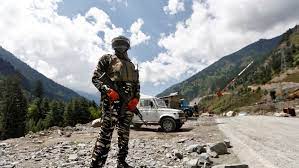
India Constructs Strategic Road in Bhutan Near China Border

 :
| Updated On: 02-Aug-2025 @ 12:46 pm
:
| Updated On: 02-Aug-2025 @ 12:46 pmSHARE
India is rapidly building infrastructure near the Line of Actual Control (LAC) to enhance military and logistical capabilities, particularly in regions close to the sensitive India-China border. A major development in this strategy is the construction of a strategic road in Bhutan, near the Doklam plateau — the site of the tense 2017 standoff between Indian and Chinese forces. The newly constructed road, which cost around ₹254 crore and was built by India’s Border Roads Organisation (BRO), connects to the Haa Valley in Bhutan, located just 21 km from Doklam. This road is seen as a significant step in strengthening regional connectivity and defense preparedness.
Inaugurated by Bhutan's Prime Minister Tobgay Tshering, the road not only benefits the local Bhutanese population by improving transportation access but also holds considerable military importance. It enhances the movement of Bhutanese security forces toward the strategic Chumbi Valley, located in the Tibet Autonomous Region, where Chinese soldiers are currently stationed. The road will allow for faster troop movement and easier transportation of supplies to border areas, which could be critical during times of heightened tension.
While the road is primarily for Bhutan’s use, India also stands to benefit from the infrastructure if the situation demands in the future. This reflects the growing strategic cooperation between India and Bhutan in response to increasing Chinese influence and border pressure. Bhutan shares a close geographical and political connection with both India and China, and India considers its alliance with Bhutan crucial to maintaining security and influence in the eastern Himalayan region.
The context for this new development stems from the 2017 Doklam standoff, when China attempted to construct a road towards the Jamferi Ridge in the Doklam area — located at the tri-junction of Sikkim (India), Bhutan, and Tibet. In response, India launched “Operation Juniper” to block the road construction. Indian troops entered Doklam and halted the Chinese activity, resulting in a 72-day military standoff. Eventually, Chinese forces withdrew, but they later returned to build helipads and other infrastructure in the region, keeping tensions alive.
The newly constructed road is part of BRO’s long-standing Project Dantak, which has been active in Bhutan since the 1960s. Under this project, five new bridges have also been built along the road, enabling year-round transportation regardless of weather conditions. The Confluence–Haa Road, now upgraded under Project Dantak, aims to support not just defense objectives but also boost transportation, tourism, and logistics for Bhutan’s development.
India’s Army Chief General Upendra Dwivedi recently visited Bhutan and was given a detailed briefing on the road’s strategic value. Lt Gen Raghu Srinivasan, Director General of BRO, also made an official visit to Bhutan to inspect the project. During his visit, he met King Jigme Khesar Namgyel Wangchuck and Prime Minister Tobgay, who lauded BRO’s contributions to Bhutan’s infrastructure growth.
Overall, the road project symbolizes India’s commitment to enhancing bilateral ties with Bhutan while reinforcing its strategic posture in the region amid ongoing Chinese assertiveness.